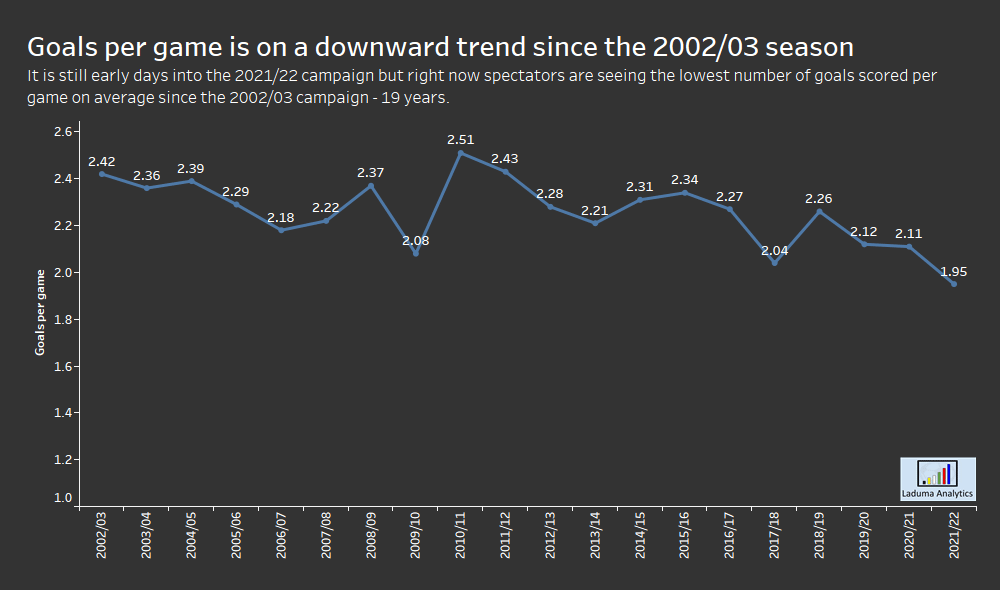
After the controversial penalty incident that saw South Africa eliminated at the hands of Ghana, the DSTV Premiership is back this weekend. With no less than 20 league fixtures in the space of 10 days, there are ample opportunities for teams and their players to score plenty of goals. Having said that, how is the trend of goal scoring in the league this season compared to previous campaigns and what can we expect going forward? Laduma Analytics gives you the insights below.
Goals Scored
At this moment in time, the league is seeing the lowest number of goals scored per game since records began. Even going back as far as the 1997/98 season when the Premier Soccer League had 18 teams, the goals per game figure was still flowing steadily at approximately 2.5 goals per game. Since the league turned to 16 teams at the beginning of the 2002/03 season, the trend has been slowly decreasing and now averaging just under two goals per game.

How Significant is This?
Considering that all teams together have managed to create 173 expected goals (xG) worth of goals but only managed to score 146 goals between them this season tells us some part of the story. Could it mean that players in the league are becoming less efficient in their scoring capabilities? Unlikely given that some players have already scored half of their end-season total and we are only 10 games into the 2021/22 campaign. Whilst extraordinarily impressive, Mamelodi Sundown’s feat of recently setting a new league record for the most league games without conceding a goal isn’t helping this trend.
Given what we know of the numbers, we can safely say that the majority of teams in the league are actively managing to create high-quality chances but are lacking the efficiency in putting these chances away. For example, if we take the number of goals that we would have expected teams to score (173) and divide that by the number of games played (79), we would be averaging a healthy 2.18 goals per game, which fits into our expectations of previous seasons above.
Shots to Goal Ratio
A very common measurement used in football is the shots to goal ratio, meaning ‘how many shots does it take to score a goal’? Whilst it is not entirely accurate as it does not consider the quality of a chance, it is commonly accepted to be 10:1. In other words, on average it takes teams 10 shots to score a goal. For the 2021/22 season, this figure still measures up at 10% as expected, so that begs the question, where is the lack of goal efficiency coming from this season?
Slow Start – Fast Catch Up
A deep dive into the league table also gives a quick indication as to how and why the goal figures are lacking. Two of the most attacking teams from last season, AmaZulu FC and 2021 MTN 8 finalists Cape Town City FC have struggled for goals since the start of this campaign. A change in the management may have brought with it some lesser attacking quality and/or efficiency, particularly in the instance of the team from the Mother City.
We also noted this in a piece on AmaKhosi earlier this season and they went on to score more goals since. When this occurs across the league, it has a major effect on the overall balance of goals which affects the fans who sit and watch the game at home. Each of the teams are creating chances for their players to score and as such with a bit of luck, the goal tally should increase very soon.
Considering that the games will come thick and fast between now and the summer break and the measurements have all passed the quality test, we believe the goals tally will increase to where we would expect it to become May 2022.
*Note: If you count the number of goals scored in the league table, the number is higher than 146. Unfortunately to matters beyond our control, three DSTV Premiership matches have no recorded match statistics and thus would skew the analysis conducted above.





























